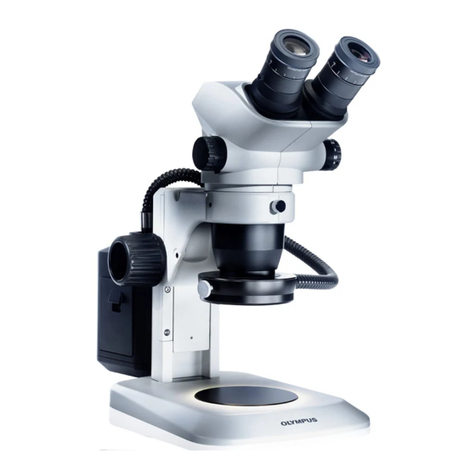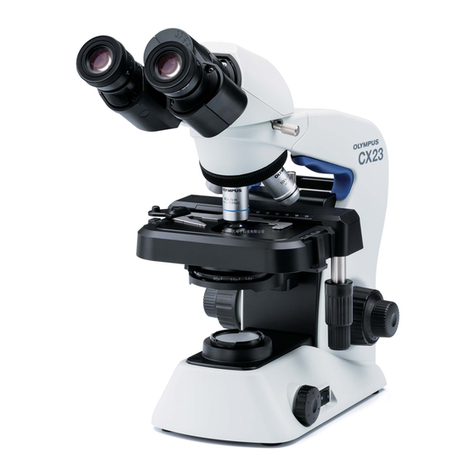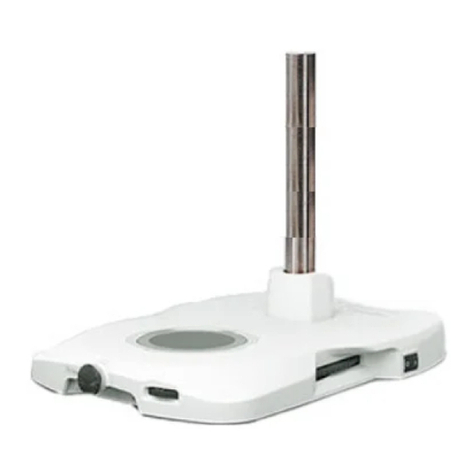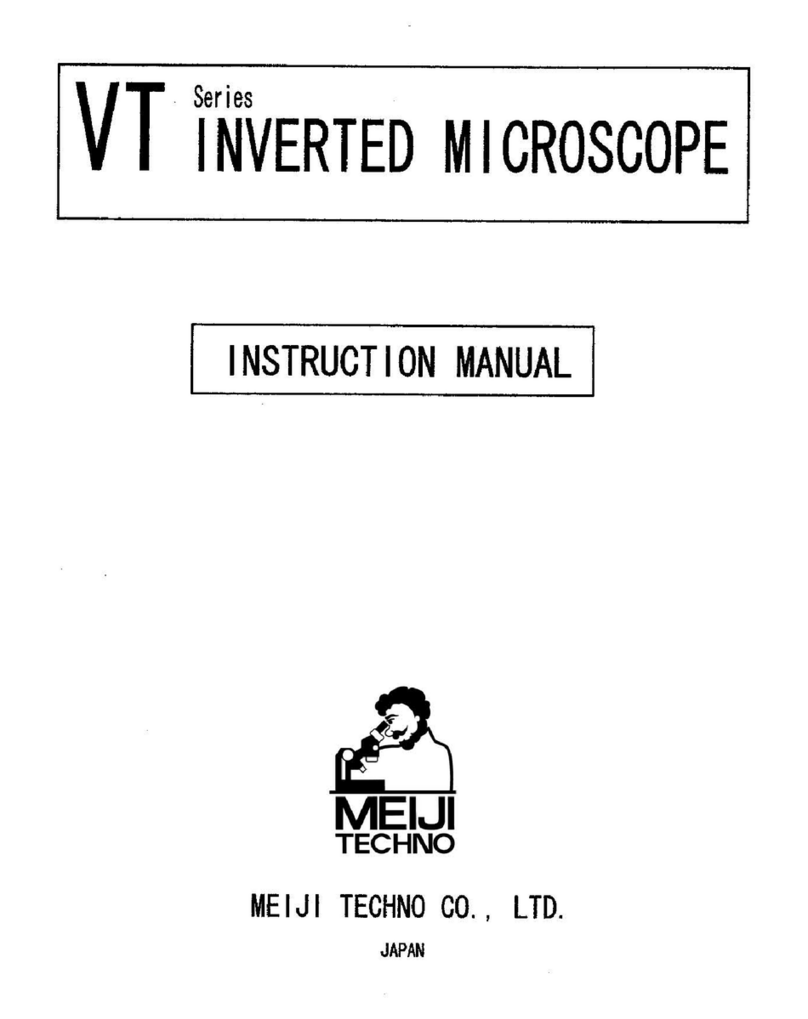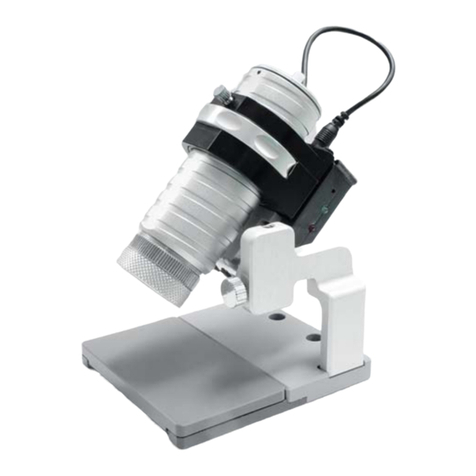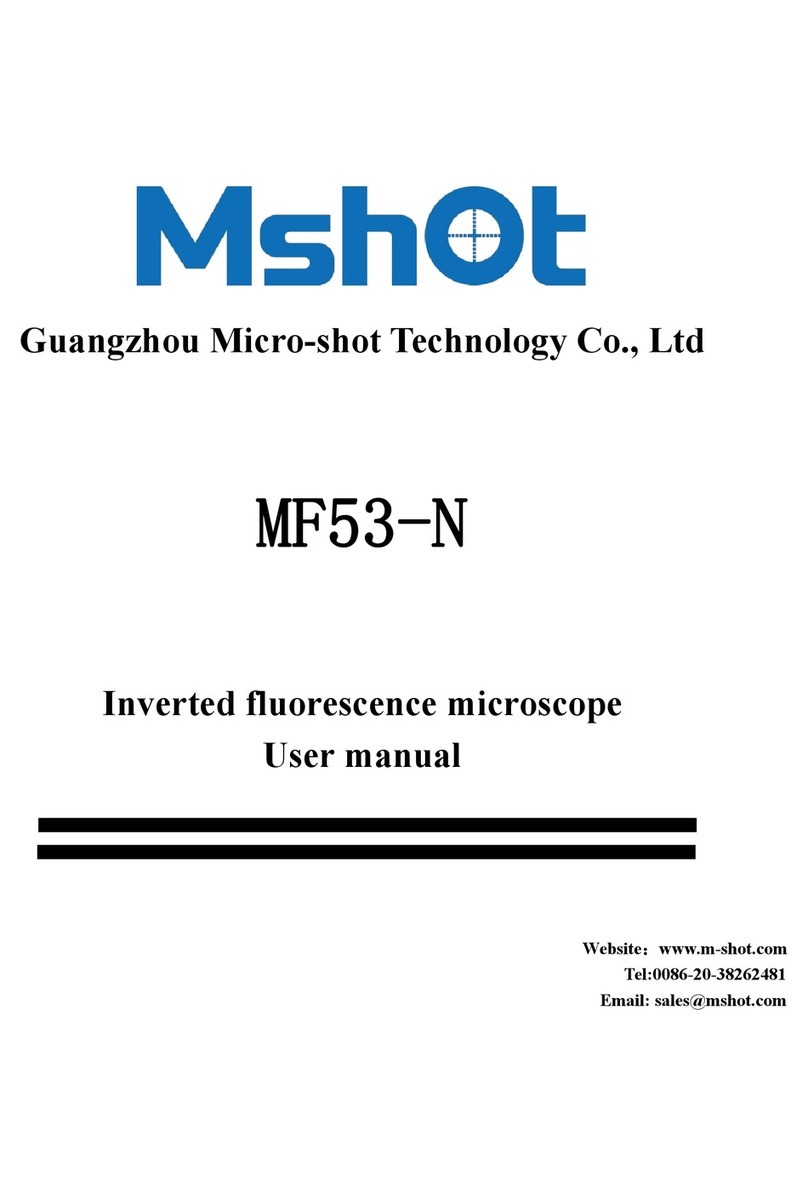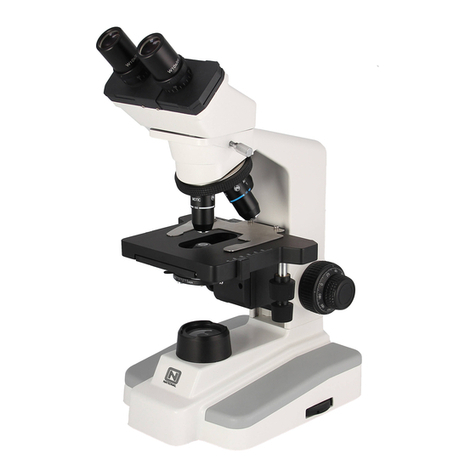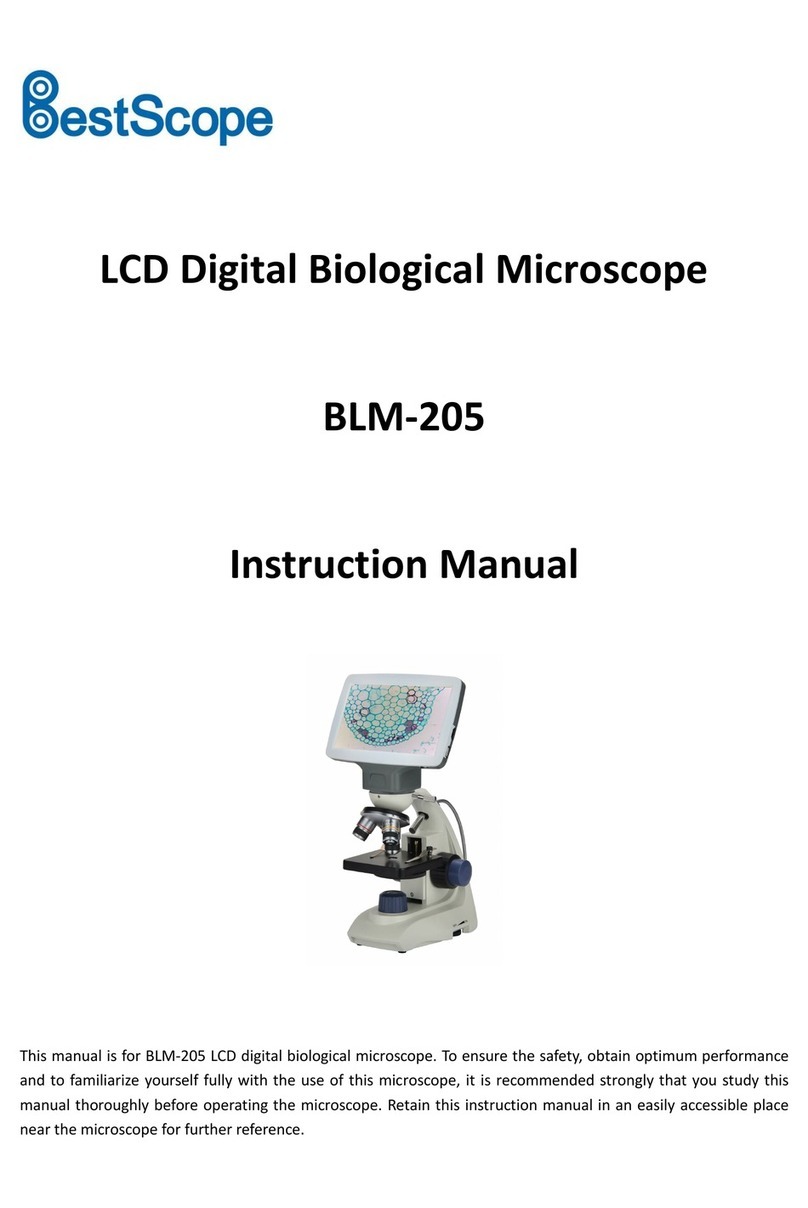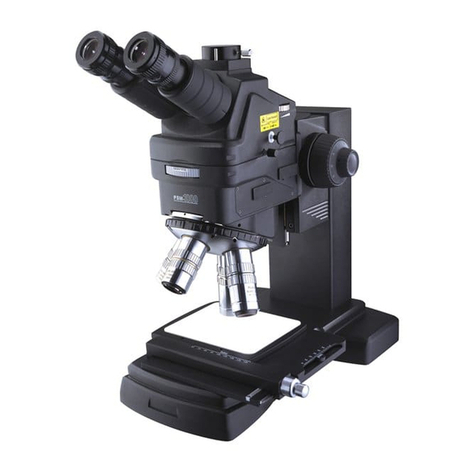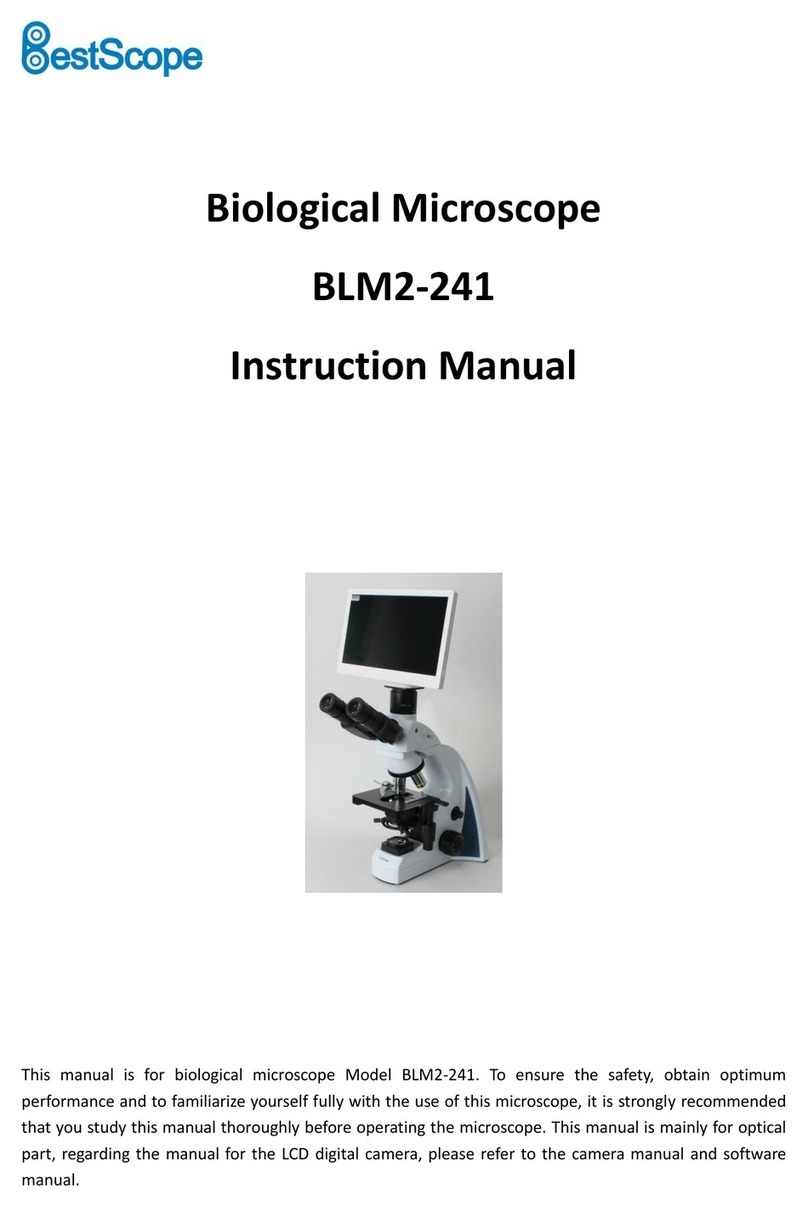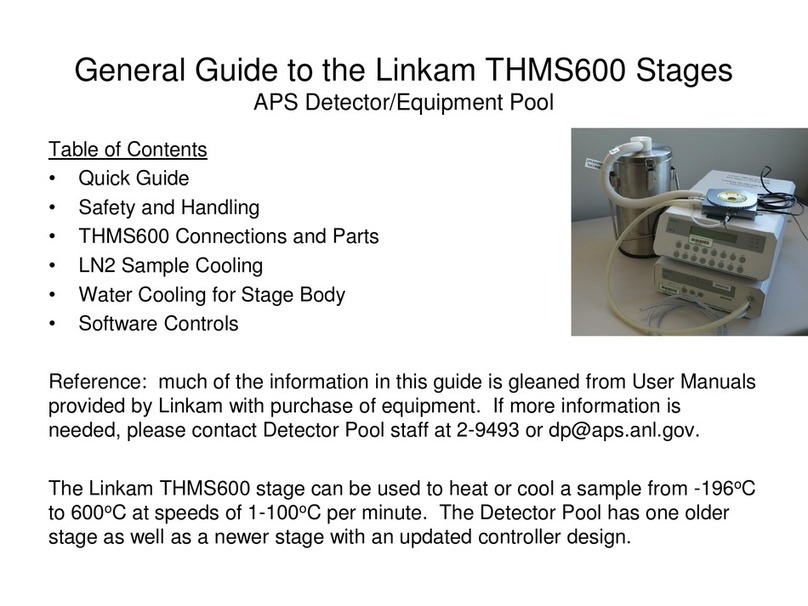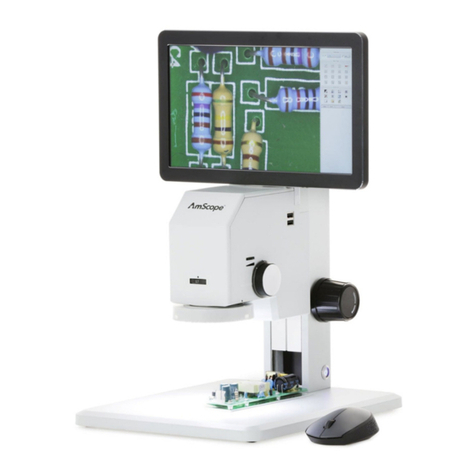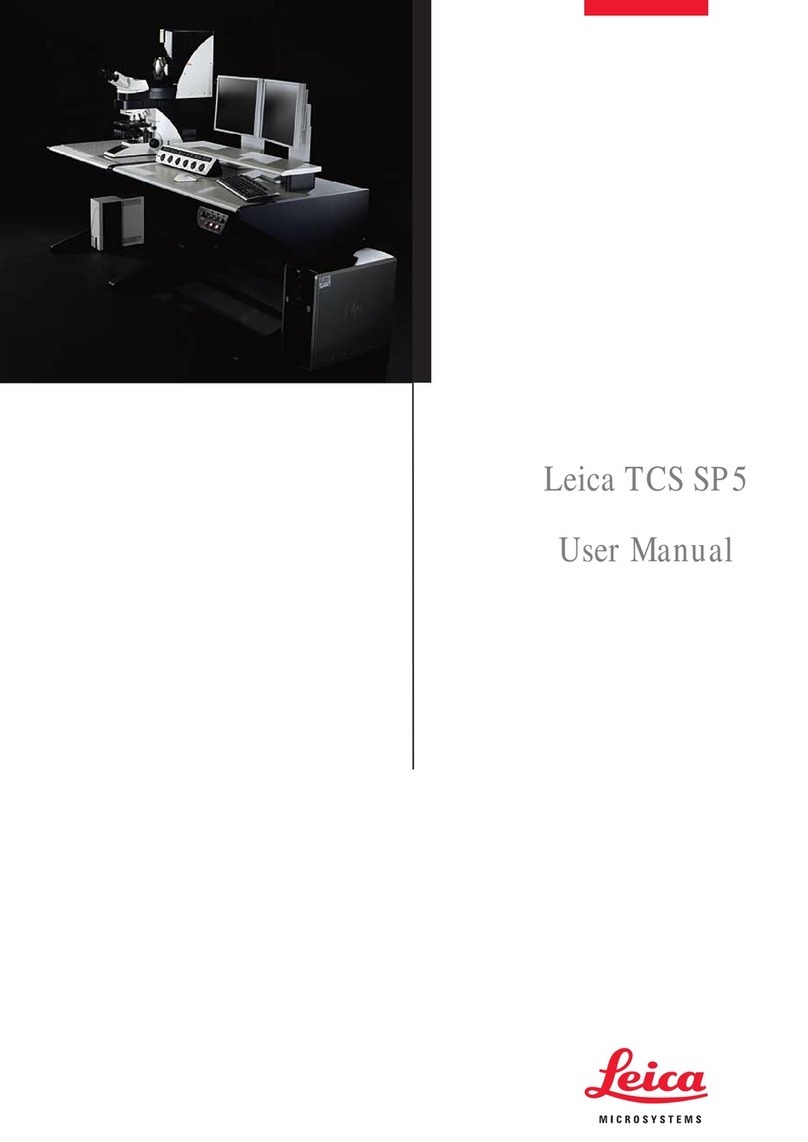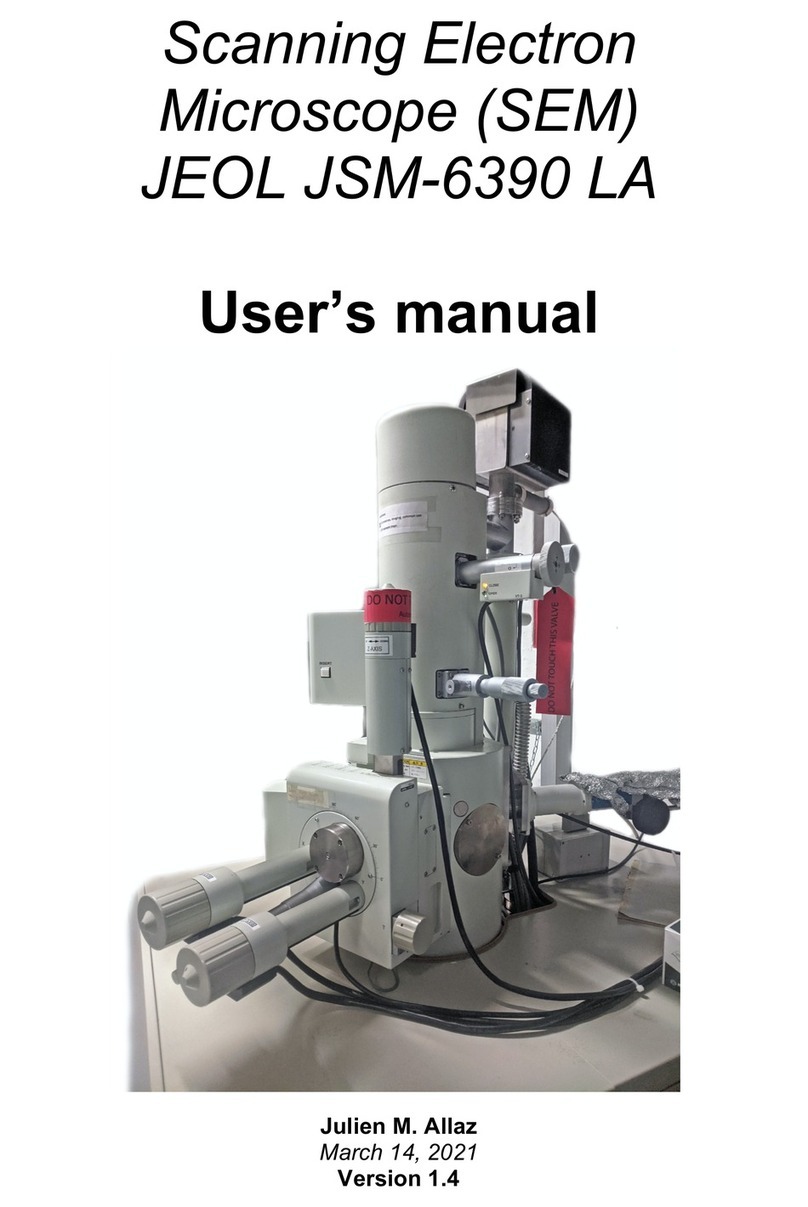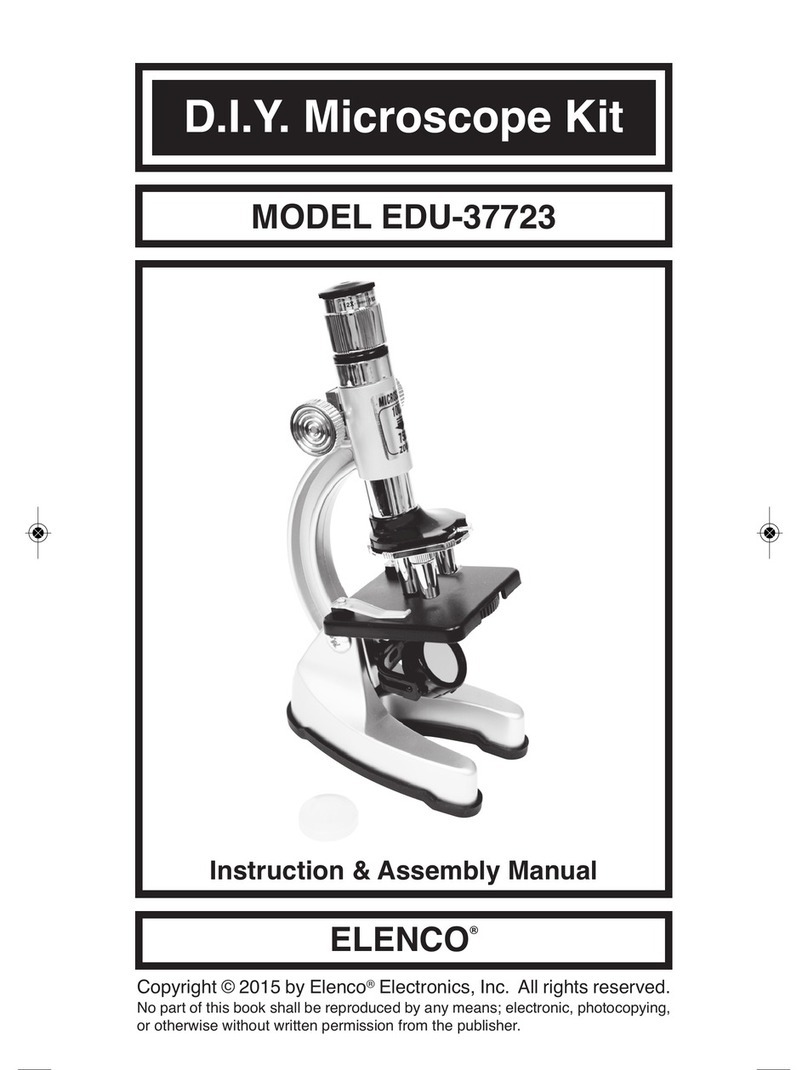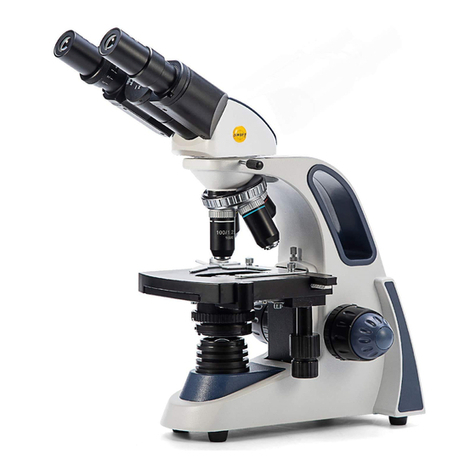Evident SZX7 User manual

INSTRUCTIONS
This instruction manual is for the Olympus stereomicroscope system. To ensure the safety,
obtain optimum performance and to familiarize yourself fully with the use of this microscope, we
recommend that you study this manual thoroughly before operating the microscope.
Retain this instruction manual in an easily accessible place near the work desk for future reference.
For details of products included in the configuration of this system, see “1 Nomenclature” (P.3)
and “9 Optional modules” (P. 19).
Stereomicroscope system
SZX7
Optical Microscope and Accessory


SZX7
Important............................................................................................................................................................. 1
1 Nomenclature........................................................................................................................................... 3
2 Controls ......................................................................................................................................................... 4
3 Observation procedure.................................................................................................................... 5
3-1 Reparation............................................................................................................................................................... 5
3-2 Procedure................................................................................................................................................................. 5
4 Operation...................................................................................................................................................... 6
4-1 Stand............................................................................................................................................................................ 6
1Using the stage...............................................................................................................................................................................6
2
Adjusting the tocus adjustment knob tension................................................................................................................6
4-2 Observation tube............................................................................................................................................... 6
1Adjusting the interpupillary distance...........................................................................................................................6
2
Adjusting the diopter (zoom confocality adjustment)
......................................................................................................7
3Using the eye shades...............................................................................................................................................................8
4Using an eyepiece micrometer disk............................................................................................................................8
5Selecting the light path (SZX2-TR30) ..........................................................................................................................9
6Adjusting the tilt (SZX2-TTR) ..............................................................................................................................................9
4-3 Microscope body.............................................................................................................................................10
1Zoom magnification indication...................................................................................................................................... 10
2Switching the click stop ON-OFF................................................................................................................................. 10
3Using auxiliary sleeve SZ2-ET (option) .........................................................................................11
4-4 Camera observation and photomicrography.........................................................................12
1Selecting the camera adapter magnification ................................................................................................... 12
2Mounting the camera adapter........................................................................................................................................12
3Selecting the camera light path.................................................................................................................................... 12
Contents
Correct assembly and adjustments are critical for the microscope to manifest its full performance. If you are going to
assemble the microscope by yourself, please read “8 Assembly” (P.16). For the assemblies of the modules for which
instruction manuals are available, refer to their instruction manuals.

5 Troubleshooting....................................................................................................................................13
6 Specifications.........................................................................................................................................14
7 Optical performance........................................................................................................................15
8 Assembly....................................................................................................................................................16
8-1 Assembly diagram .........................................................................................................................................16
8-2 Detailed assembly procedures...........................................................................................................17
9 Optional modules...............................................................................................................................19
9-1 Eye point adjuster SZX-EPA...................................................................................................................19
9-2 AS unit SZX-AS ..................................................................................................................................................19
9-3 BX stage adapter type 1 SZX-STAD1............................................................................................20
9-4 Stage adapter type 1 SZH-STAD1 ...................................................................................................22
9-5 Gliding stage SZH-SG................................................................................................................................23
9-6 Cup stage SZH-SC........................................................................................................................................24

1
SZX7
Important
1. After the equipment has been used in an observation of a specimen that is
accompanied with a potential of infection, clean the parts coming in contact with the
specimen to prevent infection.
· Moving this microscope is accompanied with the risk of dropping the specimen. Be sure to
remove the specimen before moving this product.
· Hold the bottom of the stand with one hand while holding base column with the other hand
to avoid tilting the micro-scope.
· In case the specimen is damaged by erroneous operation, promptly take the infection
prevention measures.
2. The desktop should be a level surface with an inclination of less than 3°, and the load to the
microscope should be less than 7 kg (when the SZ2-ST standard stand is used).
The microscope may become unstable when certain intermediate attachment and/or photography unit are
mounted on it. Be careful so that the microscope does not topple down.
1. A microscope is a precision instrument. Handle it with care and avoid subjecting it to sudden or severe impact.
2. Do not use the microscope where it is subjected to direct sunlight, high temperature and humidity, dust or
vibrations. (For the operating conditions, see “6 Specifications” (P. 14).)
3. Do not turn the zoom adjustment knobs beyond the stopper positions. Otherwise, the internal mechanism may be
damaged.
Do not turn the left and right zoom adjustment knobs in the opposite directions, as this will result in a failure.
4. Only one intermediate attachment having thickness up to 60 mm can be mounted on the microscope. If two
intermediate attachments or an intermediate attachment thicker than 60 mm is mounted, the image may be cut a
little.
However, the coaxial reflected light illuminator (SZX-ILLC) is not counted in the number of intermediate attachment.
When using multiple modules, they should be stacked in order of the SZX-ILLC, SZX-AS, SZX-RFA, SZX-SDO2
and SZX-EPA from the bottom to the top.
TIP
The SZX7 stereomicroscope is provided with the ESD (Electro-Static Discharge) protection specifications. It is provided with
electroconductive coating in the external finish to reduce the surface resistance and grounding lead wires in their standard
stand or system to eliminate static electricity from them.
To maintain the ESD protection performance, always use the microscope in combination with the
modules described in this manual or options having the ESD protection specifications. Otherwise, the
grounding will not work properly.
CAUTION
Safety precautions
1Getting ready

2
If the microscope is used in a manner not specified by this manual, the safety of the user may be imperiled. In addition,
the equipment may also be damaged. Always use the equipment as outlined in this instruction manual.
The following symbols are used to set off text in this instruction manual.
CAUTION : Indicates that failure to follow the instructions in the warning could result in
bodily harm to the user and/or damage to equipment (including objects in the
vicinity of the equipment).
NOTE
: Indicates that failure to follow the instructions could result in damage to equipment.
TIP
: Indicates commentary (for ease of operation and maintenance).
3Caution
1. To clean the lenses and other glass components, simply blow dirty away using a commercially available blower
and wipe gently using a piece of cleaning paper (or clean gauze).
If a lens is stained with fingerprints or oil smudges, wipe it gauze slightly moistened with commercially available
absolute alcohol.
Since the absolute alcohol is highly flammable, it must be handled carefully.
Be sure to keep it away from open flames or potential sources of electrical sparks –– for example,
electrical equipment that is being switched on or off.
Also remember to always use it only in a well-ventilated room.
2. Do not attempt to use organic solvents to clean the microscope components other than the glass components
because they use plastic resin materials extensively. To clean them, use a lint-free, soft cloth slightly moistened with
a diluted neutral detergent.
3. Do not disassemble any part of the microscope as this could result in malfunction or reduced performance.
4. When disposing of the microscope. Check the regulations and rules of your local government and be sure to
observe them.
NOTE
2Maintenance and storage
4Intended use
This product has been designed to be used to observe magnified images of specimens in various routine work and
research applications.
This includes the observation of living cells or of specimen taken from tissues to gain physiological or morphological
information at hospitals or laboratories.
Typical field of applications are genetics, human blood and tissue examination, neurology, pharmacology and cellular biology.
Further applications of this device include measurement and imaging for materials research, precision manufacturing, electronics
design and medical device fabrication. Additional industrial applications are added by individual companies and researchers.
Do not use this product for any purpose other than its intended use.
This product complies with the requirements of directive 98/79/EC concerning in vitro diagnostic medical
devices. CE marking means the conformity to the directive.
This product is applied with the requirements of EMC standard IEC/EN61326-2-6 and IEC/EN61326-1
concerning electromagnetic compatibility.
This product complies with the emission and immunity requirements described in IEC61326 series. The
electromagnetic environment should be evaluated prior to operation of this product.

3
SZX7
1 Nomenclature
The modules shown in the following diagram are merely the typical examples. For the modules that are not shown
below, please consult Olympus or the latest catalogues.
Modules marked* are given the ESD specifications.
A separate instruction manual is available for the module marked **.
Note1) The microscope can also be mounted on the SZ2-STU1/STU2/STU3 large stand as well as on the SZX2-ST SZX
standard stand by using the SZ2-STB1/SZ2-STS focusing arm.
Stage Plate
Black/White: SZ2-SPBW*
(ESD protection on black surface)
Transparent: SP-C
Other stage adapter
Stage Plate
Observation tube
Binocular tube: SZX-BI45*
SZX-BI30
Trinocular tube: SZX2-TR30
Tilting trinocular tube: SZX2-TTR
Ergonomic long tilting trinocular:
SZX2-LT TR**
Eyepiece
WHSZ 10X*
WHSZ 10X-H*
WHSZ 15X-H*
WHSZ 20X*
WHSZ 20X-H*
WHSZ 30X-H*
Microscope Body
7X Zooming microscope body:
SZX-ZB7*
Objective
DFPL 0.5X-4*
DFPL 0.75X-4*
DFPLAPO 1X-4*
SZX-ACH 1X*
SZX-ACH 1.25X*
DFPL 1.5X-4*
DFPL 2X-4*
Stand Note1)
Standard stand: SZ2-ST*
LED illuminator stand: SZ2-ILST**
LED transmitted light illumination:
SZX2-ILLTQ**
SZX2-ILLTS**
Intermediate attachment
AS unit: SZX-AS
Eye point adjuster: SZX-EPA
Extendable eyepoint adjuster:
SZX2-EEPA**
Coaxial reflected light illuminator:
SZX2-ILLC10**
Side-by-side viewing attachment:
SZX-SDO2*
Auxiliary sleeve
SZ2-ET*
Olympus classifies SZX-ZB7 as an optical microscope and other units as optical microscope accessories.

4
2Controls
Eye shades (P.8)
Click stop ON-OFF screw (P.10)
Stage plate
Allen screwdriver
Accessory mounting screws
(x 5)
Zoom adjustment knobs (P.7)
0.8X to 5.6X
Focus adjustment knob (P.6)
Stroke: 120mm
Accessory mounting holes
Diameter ø 4 mm (x 2)
Grounding holes (P.16)
For ø 4 mm banana plugs (x 4)
Allen screwdriver holder (P.16)
With double-side adhesive tape
Stage adapter
mounting screws
M4 screws (x 2)
Eyepiece clamping knobs
Stage plate
Body clamping knob
Threaded for accessory mounting
Zoom magnification indication (P.10)
Indicates 0.8, 1, 1.25, 1.6, 2, 2.5, 3.2, 4, 5 and 5.6
Zoom adjustment knobs (P.7)
Focus adjustment knob
(P.6)
0.8X to 5.6X
Allen screwdriver holder (P.16)
M4 screws (x 2)
Allen screwdriver
With double-side adhesive tape
Allen screwdriver holder (P.16)

5
SZX7
3Observation procedure
Ref. Page
1. Confirm the mounting, particularly that of the observation tube. .......................................................................................................................................Page 16 to 18
2. Adjust the rotation tension of the focus adjustment knob. ..........................................................................................................................................................................Page 6
3. Prepare the light source as required.
If you have not assembled the microscope yet, please read “8 Assembly” (P. 16) (page 16 to 18).
TIP
3-2 Procedure
3-1 Reparation
Place the specimen on the stage. (Page 6)
Adjust the interpupillary distance. (Page 6)
1
2
Adjust the eyepiece diopter. (Page 7)
(The adjustment operation is variable whether the eyepieces
use an eyepiece micrometer disk or not. )
3
Set the zoom adjustment knob afor the lowest magnification and
rotate the focus adjustment knob bto bring the specimen into
approximate focus.
Rotate the zoom adjustment knob ato the target magnification
and rotate the focus adjustment knob bto bring the specimen into
accurate focus.
When the optional AS unit (SZX-AS) is used, the contrast of
image and the focal depth of specimen can be adjusted with
the aperture iris diaphragm lever.
4
5
TIP
a
b

6
4 Operation
4-1 Stand
When reflected light illumination is used, the stage plate can be
placed either the white or black surface facing up depending on the
specimen. However, when the ESD performance is required, always
use the black surface of the stage plate.
When transmitted light illumination is used, use the transparent glass
stage plate (SP-C).
1
2
This operation is intended to facilitate the rotation of the
knobs while preventing spontaneous drop of the microscope
body. It is recommended to set the knob tension to a slightly
higher level than the point where spontaneous drop occurs.
Hold the left and right focus adjustment knobs awith both hands,
fix the left knob and rotate the right knob. The rotation tension of the
knobs increases or decreases according to the direction in which the
right knob is rotated.
If the rotation tension is increased too much, accurate focusing is not
possible and the mechanism may be damaged.
TIP
1
2
1Using the stage
2
Adjusting the tocus adjustment knob tension
a
To decrease
To increase
Clamp
Always hold the eyepiece sleeves awith both hands
when adjusting the interpupillary distance.
While holding the left and right eyepiece sleeves awith both hands,
look through the eyepieces and adjust for binocular vision until the
left and right fields of view coincide completely.
NOTE
1
1Adjusting the interpupillary distance
a
4-2 Observation tube

7
SZX7
Confirm that the eyepiece clamping knobs aare
tightened firmly before proceeding to the adjustment.
Eyepieces without eyepiece micrometer disk
Turn the diopter adjustment rings bof the left and right eyepieces to
positions “0”. (This adjustment is not possible with eyepieces without
helicoids.)
Place an easy-to-observe specimen on the stage plate.
Set the zoom adjustment knob cfor the lowest magnification and
rotate the focus adjustment knob dto bring the specimen into focus.
Set the zoom adjustment knob cfor the highest magnification and
rotate the focus adjustment knob dto bring the specimen into focus.
Set the zoom adjustment knob cfor the lowest magnification and
rotate the diopter adjustment rings dof the left and right eyepieces,
instead of the focus adjustment knob, to bring the specimen into focus.
Set the zoom adjustment knob cfor the highest
magnification again and check the image focusing. The
diopter adjustment is complete if the image in accurate focus.
If not, repeat steps
3
to
5
above.
Eyepieces with eyepiece micrometer disk
Look through the eyepiece with eyepiece micrometer disk and rotate its.
diopter adjustment ring bto bring the micrometer scale into focus.
Place an easy-to-observe specimen on the stage plate.
Set the zoom adjustment knob cfor low magnification, look through
the eyepiece with eyepiece micrometer disk and rotate the focus
adjustment knob dto bring the specimen into focus.
Set the zoom adjustment knob cfor the highest magnification,
look through the eyepiece with micrometer disk and rotate the focus
adjustment knob dto bring the specimen into focus.
Set the zoom adjustment knob cfor the lowest magnification and
rotate the diopter adjustment ring of the eyepiece without eyepiece
micrometer disk, instead of the focus adjustment knob, to bring the
specimen into focus.
·Set the zoom adjustment knob cfor the highest magnification
again and check the image focusing. The diopter adjustment
is complete if the image in accurate focus. If not, repeat steps
3to 5above.
·Note the left and right diopter scale values so that it can be
quickly duplicated in future observations.
NOTE
1
2
3
4
5
TIP
1
2
3
4
5
TIP
2
Adjusting the diopter (zoom confocality adjustment)
a
b
c
d

8
Diopter scale of the 10X eyepieces
The valid range of the diopter scale is between -8 and +5 but
a slight margin is added to it. Therefore, the diopter value may
exceed +5 or -8 when it is adjusted to the maximum. In this
case, whether the diopter value is over +8 or under -5 can be
identified by the length of the eyepiece.
TIP
-8 +5
The eye shades are not provided with ESD protection
performance. When ESD protection is required, do not use the
eye shades.
When Wearing Eyeglasses
Use with the eye shades in the normal, folded-down position. This will
prevent the eyeglasses from being scratched.
When Not Wearing Eyeglasses
Extend the folded eye shades in the direction of the arrow to prevent
extraneous light from entering between the eyepieces and eyes.
TIP
WHSZ10X-H/15X-H/20X-H
Rotate the disk-mounting ring aof the eyepiece counterclockwise
to remove.
Prepare an eyepiece micrometer disk b(24 mm dia. x 1.5 mm thick),
remove dust and dirt from its surface, and fit it into the disk-mounting
ring aso that the engraving on the micrometer disk faces downward.
Gently screw in the disk-mounting ring aincorporating the eyepiece
micrometer disk into the eyepiece. Turn the ring clockwise to attach
it firmly.
1
2
3
3Using the eye shades
4Using an eyepiece micrometer disk
1
3
2
a
b
Indication
engraved surface

9
SZX7
Slide the light path selector knob ato select the desired light path.
Light Path Selector Knob Indication Light Path Ratio
Pushed-in position Binocular 100%
Pulled-out position Binocular 50%
Camera 50%
Adjust the height and tilt of the observation tube to obtain the
most comfortable viewing position.
Holding the binocular section with both hands, raise or lower
it to the desired position.
Never attempt to force the binocular section past the
upper or lower stop position. Applying excessive force
could destroy the limiting mechanism.
TIP
NOTE
5Selecting the light path (SZX2-TR30)
6Adjusting the tilt (SZX2-TTR)
WHSZ30X-H
Rotate the disk-mounting ring cof the eyepiece counterclockwise
to remove.
Rotate the push ring dof the eyepiece micrometer disk
counterclockwise to remove.
Prepare an eyepiece micrometer disk e(24 mm dia. x 1.5 mm thick),
remove dust and dirt from its surface, place it on the disk-mounting ring
cwith the engraving facing downward, and fix it with the push ring d.
Gently screw in the disk-mounting ring cincorpofrating the eyepiece
micrometer disk into the eyepiece. Turn the ring clockwise to attach it firmly.
Due to their structures the WHSZ20X-H/30X-H eyepieces
apply a magnification on the focused plane of the eyepiece
micrometer disk.
These magnifications are 1.3X with the WHSZ20X-H and 2X with
theWHSZ30X-H.Be sureto compensatefor thesemagnifications
when using the eyepiece micrometer disk in measurements.
Also, insertion of the eyepiece micrometer disk extends the
light path length and deviates the position of the diopter
scale. Correct this deviation by turning the diopter adjustment
ring of the eyepiece toward “+”.
When the eyepiece micrometer disk is not used, store it by
wrapping in a clean, soft cloth.
1
2
3
4
NOTE
TIP
Indication
engraved surface
3
1
5
2
4
d
e
c
a

10
4-3 Microscope body
The body zoom magnification is indicated on zoom adjustment knob
(right) a.
The total magnification can be calculated with the following formula.
Total
magnification = Objective
magnification x Body zoom
magnification x Eyepiece
magnification
Magnification indication ring
An objective other than the 1X model is provided with a
magnification indication ring. Use the ring having indication
“SZX7” with the SZX7 microscope.
Widen the magnification indication ring band fit into the deep part
of the left zoom adjustment knob cso that the indicated figures can
be read from the front of the microscope.
Gently turn the magnification indication until it clicks into the
predetermined position.
The magnification indication ring can also be attached
on the right zoom adjustment knob, but the microscope
zoom magnification indication is hidden in this case.
TIP
1
2
NOTE
1Zoom magnification indication
2Switching the click stop ON-OFF
a
b
c
The click stop function provides a click stop for each zoom
magnification value indicated on the zoom adjustment knob.
When the click stop function is switched OFF, the zoom
magnification can be adjusted finely around each zoom
magnification value.
To switch the click stop function ON, turn the click stop screw d
clockwise (in the direction of the arrow) all the way until it is stopped
using the Allen screwdriver.
A click stop is provided for each zoom magnification value indicated
on the zoom magnification indication a.
To switch the click stop function OFF, turn the click stop screw d
counterclockwise (in the opposite direction to the arrow) by about 2
turns using the Allen screwdriver.
To prevent damaging the microscope cover and internal
mechanism, do not turn the screw excessively.
TIP
1
2
NOTE
d

11
SZX7
3Using auxiliary sleeve SZ2-ET (option)
As the 0.5X objective has a long working distance, it cannot be used in
combination with the standard stand unless the auxiliary sleeve is used.
When the auxiliary sleeve is used, the microscope
becomes tall and unstable. Care is therefore needed
against toppling it down.
NOTE
Microscope body
Auxiliary sleeve
Standard stand

12
4-4 Camera observation and photomicrography
Set the magnification of the camera adapter according to the size of the CCD in the digital camera.
The following figures show the camera observation areas when the WHSZ10X eyepieces with FN 22 are used.
1 in. CCD
2/3 in. CCD
1/2 in. CCD
WHSZ10X
FN 22
When the 0.5X camera adapter is used When the 1X camera adapter is used
When camera observation or photomicrography is required, use the SZX2-TR30/SZX2-TTR trinocular tube.
A digital camera unit can be mounted on the trinocular tubes by means of the camera adapter and/or camera mount
adapter *.
* The camera mount adapter is not necessary if a camera adapter equipped with a camera mount is used.
For details, please also read the instruction manuals for the camera adapter and digital camera.
Using the Allen screwdriver, fully loosen the straight tube clamping
screw aof the straight tube mount on the top of the trinocular tube.
Fit the round dovetail bof the camera adapter into the straight tube
mount of the trinocular tube, and tighten the clamping screw a.
Mount the camera on the camera adapter. A camera mount adapter
may be required with certain camera adapters.
1
2
3
Pull out the light path selector knob cto select the Binocular 50%/
Camera 50% light path setting.
1Selecting the camera adapter magnification
2Mounting the camera adapter
3Selecting the camera light path
a
c
b

13
SZX7
Problem Cause Remedy Page
1. The left and right fields of view
do not coincide.
Interpupillary distance is adjusted
improperly.
Adjust it correctly. 6
The parallax is not corrected. Adjust it correctly. 7
The left and right eyepieces are
different.
Use eyepieces with the same
magnifications for the left and right
by replacing one of them.
3
2. The edge of the field of view
is obscured or not evenly
illuminated.
The aperture iris diaphragm is stopped
down (when the SZX-AS is used).
Open the aperture iris diaphragm. 20
The binocular tube and/or intermediate
attachment are installed improperly.
Install them properly. 17
The light path selector knob is in an
intermediate position. (SZX2-TR30)
Set it properly. 9
3. Dirt or dust is visible in the
field of view.
Dirt/dust on specimen. Clean thoroughly. 2
Dirt/dust on eyepieces.
4. Details of observed image are
solid.
The aperture iris diaphragm is stopped
down (when the SZX-AS is used).
Open the aperture iris diaphragm. 20
5. Visibility of observed image is
poor.
· Image is not sharp.
· Contrast is poor.
The objective is tilted. Screw it in correctly until it stops. 17
The objective is dirty. Clean thoroughly.
2
The top and/or bottom lenses of the
microscope body are dirty.
The bottom lens of the observation
tube is dirty.
6. Zooming causes defocusing
of the observed image.
The eyepiece diopter is adjusted
improperly.
Adjust it correctly. 7
The focus adjustment is inaccurate. Adjust the focus accurately. 7
7. The focus adjustment knob
does not rotate smoothly.
The rotation tension of the knob is set
too high.
Decrease the rotation tension to
an optimum level. 6
8. The microscope body drops
spontaneously, causing the
focusing to be deviated during
observation.
The rotation tension of the knob is set
too low.
Increase the rotation tension to an
optimum level. 6
5Troubleshooting
Under certain conditions, performance of the microscope may be adversely affected by factors other than defects.
If problems occur, please review the following list and take remedial action as needed. If you cannot solve the problem
after checking the entire list, please contact Olympus.

14
6Specifications
Item Item specifications
1. Zoom microscope body
· SZX-ZB7
Zoom magnification variation: Left/right optical axis parallel method.
Zoom drive: Horizontal knob system.
Click stop for each zoom magnification: ON-OFF switching possible.
Zoom ratio values: 7 values (0.8X to 5.6X).
Zoom magnification indication: 0.8, 1, 1.25, 1.6, 2, 2.5, 3.2, 4, 5, 5.6
Objective mounting: Screw mounting into thread.
Aperture iris diaphragm control: Possible using the AS unit (SZX-AS).
2. Observation tube
· SZX-BI45
· SZX2-TR30
· SZX2-TTR
SZX-BI45 SZX2-TR30 SZX2-TTR
Binocular tube Tilting binocular tube Tilting trinocular tube
Tilting angle: 45° Tilting angle: 30° Tilting angle: 5° to 45°
Light path selection: 2 steps.
(Binocular 100%,
Binocular 50% : Camera 50% )
Interpupillary distance adjustment range: 52 to 76 mm
Eyepiece clamping knobs provided.
Eyepieces: WHSZ series eyepieces.
3. Standard stand
· SZ2-ST
Rack-and-pinion using ball guide.
Knob rotation tension adjustable.
Focusing stroke 120 mm.
Stage plate: Diameter 100 mm.
Transmitted illumination attachment (SZ2-ILA) mountable.
4. Objectives
Model Working distance
DFPL0.5X-4
DFPL0.75X-4
DFPL APO1X- 4
SZX-ACH1X
SZX-ACH1.25X
DFPL1.5X-4
DFPL2X-4
171 mm *
116 mm
81 mm
90 mm
68 mm
45.5 mm
33.5 mm
5. Eyepieces
(Note) The disk area outside the field
number is invisible.
WHSZ10X FN 22
WHSZ10X-H** FN 22, with diopter adjustment ring
WHSZ15X-H** FN 16, with diopter adjustment ring
WHSZ20X FN 12.5
WHSZ20X-H** FN 12.5, with diopter adjustment ring
WHSZ30X-H** FN 7, with diopter adjustment ring
6. Operating environment · Indoor use
· Altitude: Max. 2000 m
· Ambient temperature: 5° to 40°C (41° to 104°F)
· Maximum relative humidity: 80% for temperatures up to 31°C (88°F), decreasing
linearly through 70% at 34°C (93°F), 60% at 37°C
(99°F), to 50% relative humidity at 40°C (104°F)
* The SZ2-ET auxiliary sleeve is required when the SZ2-ST is used.
** An eyepiece micrometer disk with a diameter of 24 mm and thickness of 1.5 mm can be inserted.

15
SZX7
7Optical performance
Objective
Eyepieces
WHSZ10X/10X-H WHSZ15X-H WHSZ20X/20X-H WHSZ30X-H
Total
magnification
Actual field
(mm)
Total
magnification
Actual field
(mm)
Total
magnification
Actual field
(mm)
Total
magnification
Actual field
(mm)
DFPL 0.5X-4 4X–28X 55–7. 8 6X–42X 40–5.7 8X–56X 31.3 –4.5 12X –84X 17.5–2.5
DFPL 0.75X-4 6X–42X 36.7–5.2 9X–63X 26.7–3.8 12X –84X 20.8 –3.0 18X–126X 11.7 –1.7
DFPLAPO 1X-4 8X–56X 27.5–3.9 12X–84X 20–2.9 16X –112 X 15.6 –2.2 24X –168X 8.8 –1.3
SZX-ACH 1X 8X–56X 27.5–3.9 12X –84X 20 –2.9 16X –112 X 15.6 –2.2 24X –168X 8.8 –1.3
SZX-ACH 1.25X 10X –70X 22 –3.1 15X –105X 16 –2.3 20X –140X 12.5 –1.8 30X –210X 7.0–1.0
DFPL 1.5X-4 12X –84X 18.3 –2.6 18X–126X 13.3 –1.9 24X –168X 10.4 –0.5 36X –252X 5.8 –0.83
DFPL 2X-4 16X –112 X 13.8 –1.9 24X –168X 10 –1.4 32X –224X 7.8–1.1 48X –336X 4.4 –0.63

16
8 Assembly
8-1 Assembly diagram
The diagram below shows the sequence of assembly of the various modules. The numbers indicate the order of
assembly.
Assembly steps enclosed in will be detailed on the subsequent pages.
When assembling the microscope, make sure that all parts are free of dust and dirt, and avoid
scratching any parts or touching glass surfaces.
NOTE
* To utilize the ESD protection performance, be sure to ground the
equipment using a grounding lead wire having a 4 mm banana plug.
Eyepieces
WHSZ series
Binocular tube
SZX-BI45
Zoom microscope body
SZX-ZB7
Objective Allen screwdriver holder
Eyepiece clamping knobs
Observation tube clamping screw
Loosen using an Allen screwdriver
Body clamping knob
Stage plate
SZ2-SPBW
Standard stand
SZ2-ST
Ground lead wire
(for 4 mm banana plug) *
2
3
Allen screwdriver .
(Provided with the zoom microscope body)
Tools required
1
5
Eyepiece clamping knobs
Observation tube clamping screw
Auxiliary sleeve
SZ2-ET
Intermediate attachment
Attach to a position that does not hinder
operation.
The adhesive force weakens
when dust is attached to the
adhesive surface. Be sure to
remove dust before attaching.
NOTE
4
Table of contents
Other Evident Microscope manuals

